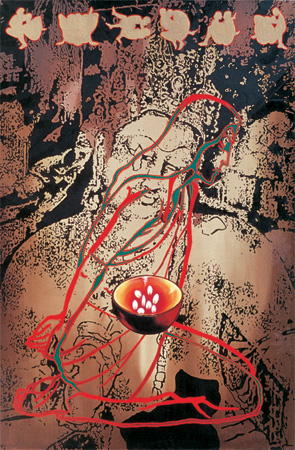What if a classic image, hitherto upheld as sublime, come to you as a mediated reality? Sachin Karne's recent works * do that, and open a pandora's box of questions. Questions about us, our world. The images Sachin chose to work upon, as a part of his 'Multiple' project, are Rembrandt's Nightwatch and Padmapani Bodhisattwa from Ajanta.
Art-/historical linkages
The reasons for choosing these images has a personal trajectory, of the experience Sachin had with two different cultures, in Netherlands and India. The images have been apparently become cultural emblems ,national tresures for the respective countries . Both images are potent with rasa : Shant Bodisattwa and Adbhuta Nightwath. While there might be hundred reasons to uphold their sublimity, Sachin Karne confronts these great works of art in atleast three ways :
- using them as Multiples, a term synonymous with Andy Warhol, thereby subscribing to the anti-art and pop-art strands,
- using them as backdrops for rather mundane images, and
- yet rendering each of the multiple with hands, thereby bowing so much to the feudal dictates of 'love for art', that the exaggerated deference would mean discontent and dissent.
Mapping the (dis) content
Sachin has grown as an artist in Gujarat, the state which has made heady headlines in the recent past and thus has attained the dubious distinction of being a marvel of mediated realitiy .(The most recent 'reality' is that, Narendra Modi is now looked ONLY as a democratically-elected, constitutional head of a state!) However,
Sachin as artist-citizen seems to distance himself from the incoherent media headlines, to take a different vantage position that enables to think wider and deeper. In his process as a visual articulator, Sachin finds signifiers for introspection.
 It is, then, a process of internalization of otherwise neutral signifiers, and disengagement of the already loaded ones. The warplanes sharing the skies with doves, soldiers posing for a photograph in a distant continent from their homes or the jubilant Babri demolition, the lotus flowers and a bowl of flames that override the lotus held by the lotus-handed Padmapani… do all of Sachin's images have an defined political context? Not so with the boy standing on a vertically dislocated springboard, circles of sex act, the self-portrait in a jigsaw with Warlol , a diver who jumps from one oblivion to another, children playing day-to-day games... are examples of 'non-loaded' signifiers who attain their roles only because the artist-protagonist wants them here.
It is, then, a process of internalization of otherwise neutral signifiers, and disengagement of the already loaded ones. The warplanes sharing the skies with doves, soldiers posing for a photograph in a distant continent from their homes or the jubilant Babri demolition, the lotus flowers and a bowl of flames that override the lotus held by the lotus-handed Padmapani… do all of Sachin's images have an defined political context? Not so with the boy standing on a vertically dislocated springboard, circles of sex act, the self-portrait in a jigsaw with Warlol , a diver who jumps from one oblivion to another, children playing day-to-day games... are examples of 'non-loaded' signifiers who attain their roles only because the artist-protagonist wants them here.
While many artists have worked in the found/ searched images mode and celebrate/question the gamut of mediated reality, Sachin's aesthetic choices find a leverage with the larger world of unproved mediations and perceived realities. He would choose to render the flames in bowl in a sensual way, but the image of bound woman that makes a conceptual backdrop for the bowl may look poster-like. In showing us the museum object of a Buddha, Sachin would choose to underline the object, its metallic existence. The photographs, in his renderings, would conform to the Magritte- Foucault cannon of the 'depicted' pipe.
What happens, then to the 'Multiple' mediations of Nightwatch and Padmapani Bodhisattwa ? They becomne maps, perhaps! Conceptual maps for the distant experience Iraq in Europe, and for the Gujrat, maybe… or simply, maps where the culturally loaded-offloaded-unloaded images find a place for themselves.
Beyond Painting
Sachin Karnes videos, perhaps of the first works he did as moving images, had retained the overall aesthetic qualities of his paintings.Use of two to three colours being the foremost of visual quality, apart from the bubbles that find place in his works. While "Mirror image - prime minister's dream project' was a direct blow on the political will that would undertake massive road-building exercise
but let the social infrastructure burn, the ' Monolithic Truth Serum Test' featured Sachin himself, more than the presence of a self-portrait within a painting. Here, the so-called apolitical, disinterested and unengaged social roles of an artist are challenged by bringing the artist himself as a suspect, apparently in one of the blazing incidents. Both the video works were done at a camp organized by ARTunderground.
-- Abhijeet Tamhane, Wed, 23 Mar 2005.
*Sachin Karne's recent suite of acrylic paintings on canvas was on display at Sakshi Gallery, Mumbai, 19th March to 4th April, 2005. The Videos were also projected at the show.
No comments:
Post a Comment